In the afternoon of Sat. Oct. 3rd, we held a workshop titled “Oil for beauty”, hosted by the Central Japan Railway Company. During the workshop, there was a talk on oils that make us beautiful from both the inside and out, as well as an oil tasting experience.
First we held a lecture at “Demizu Townhouse”, just across the street from our shop.
Then we presented the participants with a quiz:
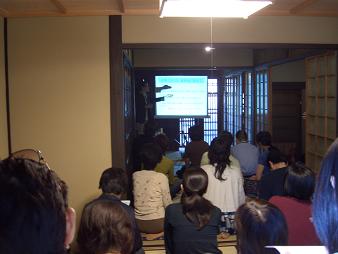
① Rapeseed oil for votive lights dedicated to Shinto or Buddhist deities
② Sesame cooking oil
③ Camellia oil for applying to hair/skin
The answer is ①. Rapeseed oil for votive lights dedicated to Shinto or Buddhist deities.
We tend to have a negative image of cooking oil, that it’s high in calories, it causes weight gain and makes your kitchen greasy, for example. However, high quality oil is not only tasty, but good for your health and enhances your beauty to boot. It can add luster to your surroundings too. The aim of the workshop was reversing the negative image of oil.
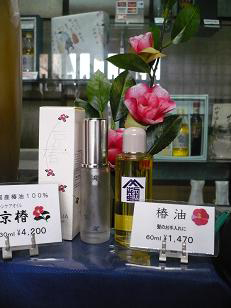
We offer two camellia oil products: “Kyo Tsubaki Camelia Skincare Oil” for skincare or haircare and “Pure Camellia Oil” specifically for haircare. As you remember, we’ve introduced camellia oil as the ultimate beauty oil.
The forthcoming winter makes us worry about dry skin.
“Kyo Tsubaki Camellia Skincare Oil” is an essential item at this time of year. You can use it as a moisturizing base before applying your makeup. It’s not only for women, it’s also very popular as an aftershave.
We recommend “Pure Camellia Oil” for your haircare regime.
Applying it to your towel-dried hair and scalp helps keep your hair moisturized and easy to style.
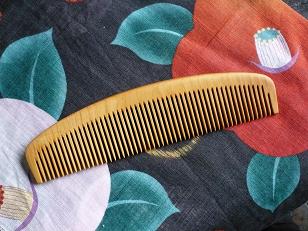 This set of camellia oil and boxwood combs has protected Japanese women’s long black hair since ancient. Boxwood tress grow very slowly and thus, while they’re tough, their tissue is very fine and its rings are delicate. These characteristics make it ideal for high-grade comb production, but it’s also used to make Japanese chess pieces and abacus beads.
This set of camellia oil and boxwood combs has protected Japanese women’s long black hair since ancient. Boxwood tress grow very slowly and thus, while they’re tough, their tissue is very fine and its rings are delicate. These characteristics make it ideal for high-grade comb production, but it’s also used to make Japanese chess pieces and abacus beads.
In the past, people rarely washed their hair and used to remove dirt and dandruff by gently rubbing camellia oil into their scalps and running a comb through their hair afterwards.
Boxwood combs don’t create static electricity and, with proper care, can be used for generations.
That’s why we also wanted to introduce how to take care of the combs.
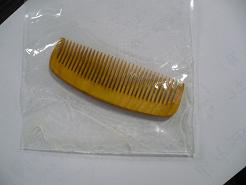 When you buy a new boxwood comb, place it in a plastic bag with five to ten drops of camellia oil and leave it to soak overnight.
When you buy a new boxwood comb, place it in a plastic bag with five to ten drops of camellia oil and leave it to soak overnight.
Since boxwood combs are made of high-grade wood, please be sure to only use camellia oil when caring for them.
The boxwood comb needs to be cleaned and cared for every two to three months.
A comb with fine teeth is particularly apt to retaining dirt and dandruff, so if it is not well-oiled, the comb ends up absorbing the grease from your scalp.
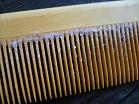 Although it may seem like a hassle to have to clean your boxwood comb, you can save plenty of time by using camellia oil. Soak a cotton bud with camellia oil and run it over the comb. Leave it for about 10 minutes and then gently clean the comb with a soft toothbrush. For fine dirt between the teeth of the comb, use something like an interdental brush or dental floss. The word “toothbrush” suddenly takes on a second meaning when you us it on the teeth of your comb!
Although it may seem like a hassle to have to clean your boxwood comb, you can save plenty of time by using camellia oil. Soak a cotton bud with camellia oil and run it over the comb. Leave it for about 10 minutes and then gently clean the comb with a soft toothbrush. For fine dirt between the teeth of the comb, use something like an interdental brush or dental floss. The word “toothbrush” suddenly takes on a second meaning when you us it on the teeth of your comb!
Since camellia oil doesn’t dry out, it’s the perfect oil for moisture preservation and oil retention It’s referred to as a non-drying oil.
To keep items or furniture around you looking its best, drying oils are used as they are more readily absorbed and provide a highly waterproof sheen.
Perilla seed oil, tung oil, and linseed oil all belong to this category of oils that dry and are indispensable in the upkeep of the wooden lattices used in Kyoto’s townhouses. After you coat the wood with persimmon tannin or red ocher, which has insecticidal and antiseptic properties, oil is thoroughtly rubbed into the wood.
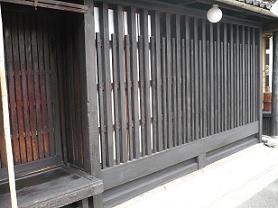 Yamanaka’s red ocher lattices have been treated with rapeseed oil.. However, rapeseed oil is considered a half-drying oil. Our fifth owner, now 86 years old says “Drying-oil is something you use at the very end”. This means that now, after two hundred years, we are still maintaining the wood with half-drying oil, our lattices have not reached the point of needing a drying-oil finish.
Yamanaka’s red ocher lattices have been treated with rapeseed oil.. However, rapeseed oil is considered a half-drying oil. Our fifth owner, now 86 years old says “Drying-oil is something you use at the very end”. This means that now, after two hundred years, we are still maintaining the wood with half-drying oil, our lattices have not reached the point of needing a drying-oil finish.
Therefore, we still treat the lattices with rapeseed oil, overlapping the profundity of life lessons with the oil.
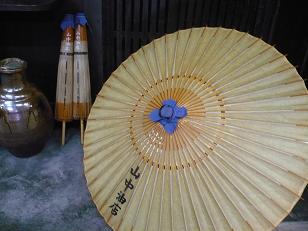
Aside from red ocher lattices, drying oil is also applied to “washi” or traditional handmade Japanese paper when making ban-gasa, traditional Japanese umbrellas. We cannot help but marvel at how much knowledge regarding the myriad uses of various oils our ancestors were able to accumulate through experience.
After the lecture, we moved onto a café/wine bar called “Ryoki-den” for the next bit of fun – oil and food tasting!
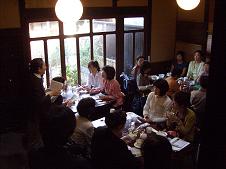
Having ice-cream drizzled in oil!
One of the most popular items on Ryoki-den’s dessert menu is their “Amazing! Vanilla Ice-cream”.
They use a special “something” as an ice-cream topping. The topping is, you guessed it, olive oil!
It’s so delicious that people actually voice their amazement – you hear “wow! That’s amazing!” from every corner of the café. That’s how it got its name.
At the workshop, our guests tried our olive oils infused with orange and lemon, as well as our ball-pressed pure sesame seed oil and fragrant peanut oil. Here is what we heard:
“It’s much tastier than expected!”
“How can oil be so refreshing?”
“Ice-cream with sesame oil was especially fun because it suddenly gave the ice-cream a hint of Japan!”
We would like to thank our twenty guests who came from all over the country.
We also appreciate the patience of those applicants who exceeded our capacity.
Whether you were able to come to the workshop or not, we hope to have the pleasure of meeting you at our shop.

